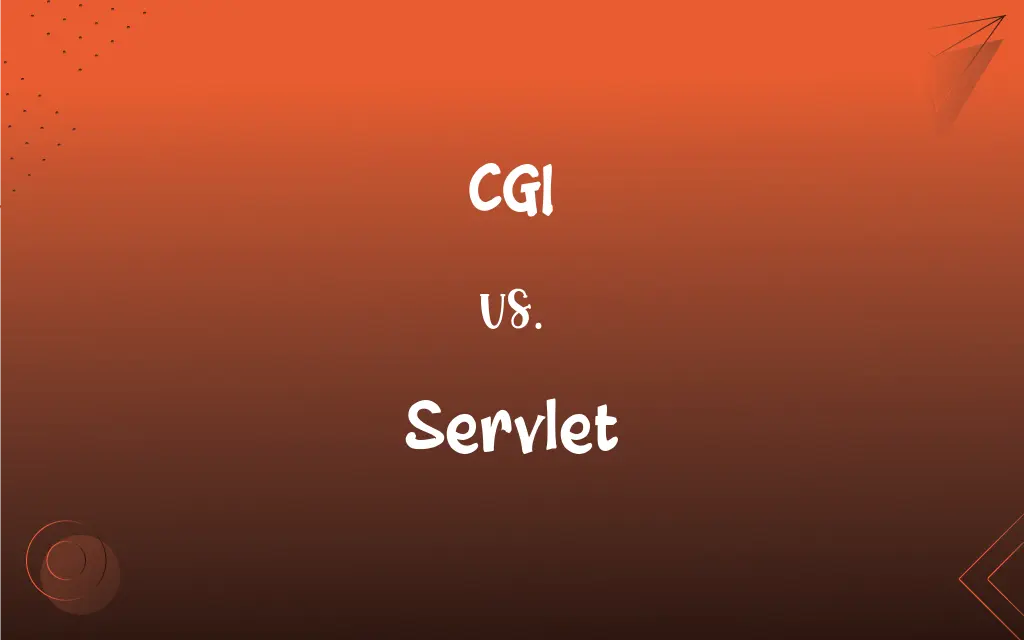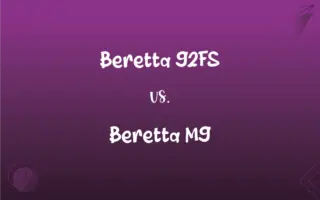CGI vs. Servlet: What's the Difference?
Edited by Aimie Carlson || By Janet White || Published on February 25, 2024
CGI (Common Gateway Interface) is a standard for interfacing web servers with executable scripts, while Servlets are Java programs that extend server capabilities, often within web servers.

Key Differences
CGI (Common Gateway Interface) and Servlets are both technologies used to create dynamic web content. CGI is a standard that allows external applications or scripts to interact with web servers. It works by starting a new process for each request, which can be resource-intensive. Servlets, on the other hand, are Java programs that run within a web server, handling requests and responses within the server's JVM (Java Virtual Machine). This allows Servlets to be more efficient, as they don't require the server to start a new process for each request.
CGI scripts can be written in various programming languages like Perl, Python, or C++. They are platform-independent but can be slower due to the overhead of creating a new process for each request. Servlets are strictly Java-based, offering the advantages of Java's portability and extensive libraries. They also enable session tracking, which is more complex to implement in CGI.
Servlets offer better performance compared to CGI as they can maintain persistent database connections and other resources, while CGI scripts need to establish these connections anew with each request. Servlets are also more scalable, handling large numbers of requests more effectively.
CGI's simplicity makes it easy to deploy and understand, suitable for small to medium-sized web applications. However, for larger applications demanding efficiency and scalability, Servlets are preferred due to their ability to handle complex processing and maintain state across multiple requests.
In terms of security, Servlets generally offer more robust features compared to CGI. Servlets allow for finer control over input validation and can interact securely with server-side resources, while CGI scripts require careful coding to prevent security vulnerabilities.
ADVERTISEMENT
Comparison Chart
Language Support
Supports multiple languages (Perl, Python, C++)
Java-based
Process Handling
Creates a new process for each request
Runs within the server's JVM
Performance
Less efficient due to process creation
More efficient with persistent resources
Use Case
Suitable for simpler, small-scale applications
Ideal for complex, large-scale web applications
Scalability
Less scalable, limited by process handling
Highly scalable, efficient under load
ADVERTISEMENT
CGI and Servlet Definitions
CGI
CGI is a protocol for interfacing external applications with web servers.
Their website used a CGI script for form processing.
Servlet
Servlets provide efficient handling of concurrent requests.
Their high-traffic site relied on Servlets for scalability.
CGI
CGI scripts can be written in various programming languages.
They implemented the CGI using Python for its simplicity.
Servlet
Servlets run within a web server's Java environment.
The Servlet efficiently processed requests within the server's JVM.
CGI
CGI starts a new process for each client request.
Each user query initiated a separate CGI process on the server.
Servlet
Servlets offer advanced features like session tracking and security.
User authentication on their site was handled securely by a Servlet.
CGI
CGI is platform-independent and easy to deploy.
They chose CGI for its compatibility across different server environments.
Servlet
Servlets are Java programs that extend the capabilities of servers.
They used a Servlet to manage session data on their website.
CGI
CGI is suitable for small to medium web applications.
Their small online store used CGI for handling customer orders.
Servlet
Servlets are used for complex, large-scale web applications.
The e-commerce platform was powered by Servlets for better performance.
Servlet
A Java program running on an Internet server that generates web content dynamically in response to requests from clients.
FAQs
Is CGI still used?
While less common now, CGI is still used, especially in legacy systems.
What are the drawbacks of CGI?
CGI can be slower and less efficient than newer technologies due to creating a new process for each request.
What is CGI?
CGI is a standard protocol used to enable web servers to execute external programs, often to generate web content dynamically.
How does CGI work?
When a request is made, the web server passes it to a CGI program. The program executes and sends the output back to the server, which forwards it to the client.
What's the advantage of Servlets over CGI?
Servlets are more efficient than CGI as they run within the server's process and don't require a new process for each request.
What languages are used for CGI scripting?
Common languages include Perl, Python, and C.
How is CGI different from server-side scripting?
CGI is a protocol for interfacing external applications with web servers, while server-side scripting often refers to embedding scripts directly in web pages.
What is a CGI file?
A CGI file is a script written in a programming language like Perl or Python, designed to be executed by a web server.
How do Servlets work?
Servlets process incoming requests, generate content (often HTML), and provide responses to clients.
Are CGI scripts secure?
If not properly written, CGI scripts can introduce security vulnerabilities.
Can CGI scripts maintain state?
CGI scripts are stateless, but they can maintain state using mechanisms like cookies or session variables.
Are Servlets platform-independent?
Yes, being Java-based, Servlets are platform-independent.
How do Servlets handle concurrency?
Servlets can handle multiple requests concurrently using multithreading.
What is a Servlet container?
A Servlet container is a part of a web server or an application server that provides the environment for Servlets to run.
How is security managed in Servlets?
Servlets support security through Java's robust security model, including features like authentication and authorization.
How do Servlets communicate with databases?
Servlets communicate with databases using JDBC (Java Database Connectivity) to perform operations like querying and updating data.
Can Servlets maintain state?
Yes, Servlets can maintain state using sessions and cookies.
What is the difference between a Servlet and a JSP?
Servlets are Java programs for handling requests, while JSPs (JavaServer Pages) are HTML pages with Java code, mainly used for presentation.
How does CGI handle form data?
CGI scripts receive form data via standard input or environment variables and process it accordingly.
What is a Servlet?
A Servlet is a Java-based technology used to extend the capabilities of a server, typically used for web applications.
About Author
Written by
Janet WhiteJanet White has been an esteemed writer and blogger for Difference Wiki. Holding a Master's degree in Science and Medical Journalism from the prestigious Boston University, she has consistently demonstrated her expertise and passion for her field. When she's not immersed in her work, Janet relishes her time exercising, delving into a good book, and cherishing moments with friends and family.
Edited by
Aimie CarlsonAimie Carlson, holding a master's degree in English literature, is a fervent English language enthusiast. She lends her writing talents to Difference Wiki, a prominent website that specializes in comparisons, offering readers insightful analyses that both captivate and inform.































































